"Casino Profits Help Pequot Indian Tribe Reclaim Its History," by Judith H. Dobrzynski, New York Times, September 1, 1997
 Foxwoods Resort Casino on the Mashantucket Pequot Indian Reservation in Ledyard, Conn., opened 1992 and has become the world's largest casino. (AP)
Foxwoods Resort Casino on the Mashantucket Pequot Indian Reservation in Ledyard, Conn., opened 1992 and has become the world's largest casino. (AP)
|
LEDYARD, Conn. - History books may now have to acknowledge what Theresa H. Bell, a member of the Mashantucket Pequot Tribal Nation, has always felt in her heart: The Pequots did not disappear in the 17th century when, ravaged by the combination of a war with the colonists and smallpox, measles and other European diseases, the tribe supposedly succumbed to European culture and was assimilated. That is what the gently rolling woodlands of southeastern Connecticut seem to say. And the secrets archaeologists are unraveling here bring vindication to a group that was sometimes derided in the 1970s for seeking federal recognition as a tribe, the purest Pequot being a one-eighth Pequot, and the accompanying right to operate a casino. Now, profits from Foxwoods, the Pequots' 24-hour-a-day casino, are paying for a $135 million museum and research center to house evidence found mere footsteps away from the conspicuously turquoise-and-purple gambling hall. More than $1 million has been spent on the dig itself. The findings unearthed by archaeologists suggest that the Pequots not only endured but also maintained many native practices -- what they ate, how they cooked, how many family members lived together and more -- through at least the 18th century. "We knew there had to be a story underneath the ground that hadn't been told," said Ms. Bell, granddaughter of Elizabeth George Plouffe, who pressed the dispersed tribe to reunite a quarter-century ago and was the founder of the modern Pequot nation. "This just proves what our oral history says."
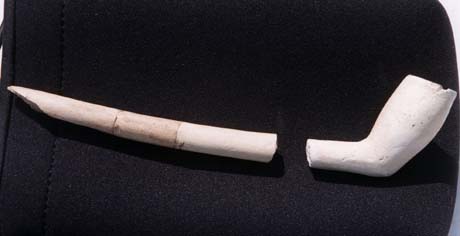 Pieces from two different clay smoking pipes from the remains of a fort built in the 1670's on the Mashantucket Pequot reservation in Connecticut
Pieces from two different clay smoking pipes from the remains of a fort built in the 1670's on the Mashantucket Pequot reservation in Connecticut
|
The evidence backing Ms. Bell comes from the discovery of the trace remnants of a fortified Pequot village, probably built in 1670 and abandoned in 1675, and several 18th-century dwellings. There are fragments of wampum, nuts, flint, tools, the oldest peach pit in the Northeast (probably) and much else. The biggest treasure is an earthenware cooking pot, as big as a pumpkin, pieced together from shards. Together, these clues tell how the Pequots hung on after they began their long slide in 1637. That year, after a series of raids by English colonists intent on taking the Pequots' land and taking over their fur trade, soldiers killed about half of the tribe in a battle at Mystic that lasted less than an hour. Then they burned down the Pequots' homes. There is much work to do to before history could actually be revised, but many experts agree it should be. "This archaeology is really going to be important," said Kathleen J. Bragdon, an anthropology professor at the College of William and Mary in Williamsburg, Va., who has visited the sites and is the author of "Native Peoples of Southern New England."
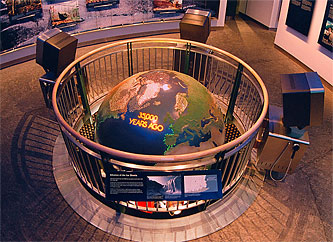 Glacial Earth World Model at the Mashantucket Pequot Museum and Research Center Mashantucket, CT
Glacial Earth World Model at the Mashantucket Pequot Museum and Research Center Mashantucket, CT
|
Kevin A. McBride, an associate professor of archaeology at the University of Connecticut at Storrs who is the director of research for the Pequots, said: "We now understand how they survived and maintained their cultural integrity. After all this is done, we will know, in terms of the Pequots, more about natives after their contact with the Europeans than has ever been known before." And he sees further ramifications. "I believe that what we're finding here is not unique, that this has broader implications" for other Indians of New England, he said. "The individual decisions that each tribe made were different. But they made decisions that would assure and maintain their culture." He said the findings supported his belief that the tribes "were not passive," as the colonists had said. In addition to traces of the Pequots' staying power, McBride has also found material that places their ancestors backward in time: vestiges of a prehistoric camp site dating back 10,000 years, with hints, as yet unproven, of evidence from 11,000 years ago. "Ten thousand years is very old for a documented site in New England," Bragdon said. "There are others of that period in other parts of North America, but this is one of the first that shows continuous occupation in New England."
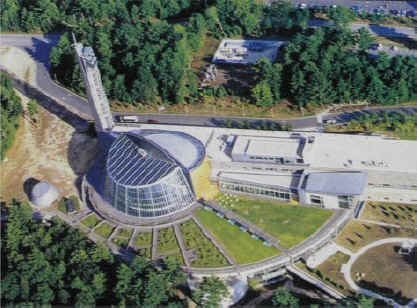 aerial view of Mashantucket Pequot Museum and Research Center that opened 1998
aerial view of Mashantucket Pequot Museum and Research Center that opened 1998
|
Next June 1, the 301st anniversary of the massacre at Mystic, the tribe plans to open its museum complex, with Ms. Bell as executive director. It will devote 85,000 square feet to telling the tribe's story and 5,000 square feet to galleries for special exhibitions about the culture of other American Indians. It will also house a research center and library. The complex, conceived 30 years ago, was one reason the tribe built Foxwoods, whose annual gross revenues approach $1 billion. Some of the profits, which have not been disclosed, have been invested in fisheries and a shipyard and used to make an annual payment to all 400 tribe members and pay fees to Connecticut. But some have always been earmarked for the research and the museum. "We realized we'd need to generate a lot of money because we wanted to understand and find parts of our history and culture that had been lost for so many years," said Ms. Bell, whose own hopes were reinforced by memories of the bottles and arrowheads and other trinkets she found on the reservation as a child on her personal "treasure hunts."
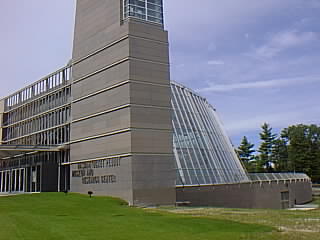 Mashantucket Pequot Museum and Research Center, Mashantucket, CT
Mashantucket Pequot Museum and Research Center, Mashantucket, CT
|
Professor McBride, who is not an Indian, had no such hopes rooted in his background when he set out in 1983 to study the Pequots' native grounds. "I didn't think much would be here," he said recently. "Most of the archaeological record has been destroyed." Laurence M. Hauptman, a history professor at the State University College at New Paltz, N.Y., and a co-author of "The Pequots in Southern New England: The Fall and Rise of An American Indian Nation," explained why. "Village sites are hard to find because most are now other towns, like New London," he said. "We Europeans didn't discover the geopolitical or economic importance of certain sites." While the Pequots once presided over a 250-square-mile territory, McBride's most important finds are taking place on the 214 acres that, saved from encroachment, eventually were established as a reservation. Many finds have simply emerged accidentally. Early this year, for example, the contractor for a parking garage wanted to move some soil on a small south-facing slope nearby. "He cut in, and we saw some of this," McBride said, pointing to thin, dark stains that look like chocolate frosting in a sandy-colored layer cake. These blotches teem with the residue of a 10,000-year-old civilization: pit houses, probably made of wood pieces and beams, maybe covered with hide or sod, for perhaps 5 to 15 people. Since winter, graduate and undergraduate archaeology students from the University of Connecticut and other colleges have been digging, separating soil samples into plastic bags, sifting some to find artifacts and storing others. The alternating layers of dark and light suggest that a family returned to this site each winter to enjoy its southern exposure but left for a less tethered life for the rest of the year.
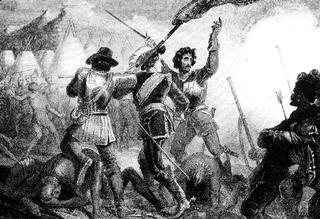 Puritans destroy Pequot fort 1637
Puritans destroy Pequot fort 1637
|
The fort is the coolest thing we've found," McBride said. Although nothing but tiny fragments has been uncovered, he gets little argument from other experts. "To find something like this fort, from this time period, is unique," Hauptman said. "Here, in Esopus country," he added, naming a Delaware Indian tribe, "we know there was an Indian fort, and we've never found it. Archaeologists have been looking for it for a century." As McBride tells the story, discovery of the Pequot fort was serendipitous. Stopping his red Toyota Land Cruiser on a bumpy dirt road leading to it, he said the modern Pequots planned a maintenance building on the site. Because the Pequots send in the archaeologists whenever they plan to build, Professor McBride and his staff members explored. With some core drilling, they found some stone tools, English flint and other "bits and pieces that told us there was a historic site here," he said. That was in 1986, and it was enough to stop the construction. More intense work followed in the early 1990s. The crews found artifacts from the 1780s: some brass, some beads. "We thought it was a 1780s farmhouse," McBride said. "But slowly it began to dawn on us that we might have found something from the 1670s. We found Pequot pottery that doesn't date after 1680," judging by its style. They have also tested their findings with radioactive carbon dating. Then came the revelation. The archaeologists had found one long black stain of material and another long black line perpendicular to it. "It came to me on Block Island," where he had gone for some respite, McBride said. "I woke up at 3 a.m. and said, 'God, it's a fort.' I called back and said: 'Connect the dots. Extend the two lines and dig and see if you get a corner." His colleagues did.
Eventually, diggers discovered a square fort, with bastions at the corners. The design demonstrates that the Pequots, who sided with the English in King Philip's War, an Indian uprising to turn back the Puritans that engulfed New England in the 1670s, learned from them. Records show that a previous Pequot fort, from 1637, was circular, not square, and lacked bastions. A forge, meanwhile, demonstrates that the natives used European technology in gunsmithing. Inside the fort is a village of eight to 10 houses, yielding a trove of fragments from iron kettles, pothooks, pottery pots with Pequot marks, pipes stamped with English makers' marks, wampum, musket balls, gun flints, arrow points, spear points and decorative objects. "We also found two garbage dumps," McBride said, "one in which everyone threw everything and one in a wigwam with incredible food remains." These included indications of nuts, corn, beans, squash, peach pits, pig, deer, raccoon, duck, turkey, geese, and fish from both the coast and local ponds.
Clearly, the Pequots interacted with the English colonists in many ways at least as early as the 1670s. Sites where wampum was manufactured and stored suggests, too, that they "were probably getting rich, though not rich in the European sense," said Bragdon of William and Mary. Sifting through all the information, McBride can surmise much else about Pequot life. The presence of more than one fire in a household, for example, suggests that extended families lived together, possibly siblings as well as grandparents, parents and children. The food wastes tell a tale that differs from colonial records, which are heavy on the improvements Europeans brought to Indian meals. The Pequots apparently did eat domesticated animals like pigs, but they also continued to fish, hunt and gather food from nature. "When you look at all the food remains, you'll find, with a few exceptions, an overwhelming native eating pattern," McBride said. The Pequots also continued to cook outdoors in pits.
The existence of the Pequot fort itself provides another example of divergence from accepted wisdom. "History says they were not well-organized, but this shows they were well-organized, with an organization that allowed them to maintain their own practices and take advantage of the fur trade," Professor Bragdon said. "What Kevin has," she added, "documents their active participation in the fur trade and shows that they were real players in the economy, not pawns of the Europeans." McBride sums up what he has learned this way: "We are finding European cultural influences, but also native culture underlying it." Instead of assimilating, the Pequots made strategic retreats. To Ms. Bell, the discoveries ring true. "I am glad we started this," she said. "We don't need an archaeological site to learn a lot of this; my grandmother still cooked outside, and I have a fire pit, too. But other people do. Outside people have to have proof to change the history books."
Foxwoods Casino home page
Mashantucket Pequot Museum and Research Center






